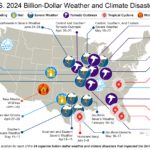A year after Superstorm Sandy inundated the East Coast with record flooding that left 159 people dead, residents of the hard-hit New Jersey shore still have a ways to go in rebuilding damaged communities.
The state’s governor, Chris Christie, began his day at the beach town of Seaside Park, where homes were flooded by two to three feet of water when the storm roared ashore and faced another disaster this September when wiring damaged by the flooding sparked an enormous fire that destroyed several blocks of boardwalk that had been rebuilt after Sandy.
Christie recalled how, in the immediate aftermath of the storm that damaged about 650,000 homes along the coast—with New Jersey, New York and Connecticut the hardest hit—he had estimated it could take two years for the state to fully recover.
“We’re about halfway there,” Christie told town firefighters and local officials on Tuesday. “We all have to acknowledge that there are still thousands of people out of their homes.”
Throughout the Northeast, residents in storm-hit shore communities are still coping with damaged homes and waiting for $48 billion in federal aid pledged for rebuilding, which officials have acknowledged has been paid out slowly.
Federal officials on Monday unveiled plans to release a second $5 billion round of funding from the Sandy relief fund, for New York State and City, New Jersey, Connecticut, Maryland and Rhode Island. The money is aimed at rebuilding and repairing homes damaged by the storm.
Sandy, a rare, late-season tropical storm, made landfall at slightly below hurricane strength, but its winds extended over a massive 1,000 miles, causing a storm surge that flooded downtown Manhattan and long stretches of the New Jersey shore, leaving millions in the dark, some for weeks.
The floodwaters breached New York City’s subway system, which was partially out of commission for much of the following week, and left many area residents struggling for weeks to find adequate supplies of gasoline as power outages left homes dark and cold and filling stations closed.
Congress initially authorized $50 billion for Sandy recovery, but the automatic spending cuts that kicked in earlier this year reduced that target to about $47.9 billion.
In Seaside Park—located a few miles from the carnival rides of Seaside Heights, the town made famous by MTV’s “Jersey Shore”—about 64 homes remain uninhabitable, said Mayor Robert Matthies. State officials said it is difficult to estimate how many families are displaced statewide since some people have moved in with family or friends rather than register for aid.
Focus on Preparedness
Sandy also prompted officials across the region to rethink storm preparedness. New York City Mayor Michael Bloomberg in June proposed a $20 billion plan to prepare the city to better handle future storms, with measures ranging from new flood walls to building up beaches, which can be natural barriers.
While this year’s Atlantic hurricane season has been the quietest in 45 years, with only two storms reaching hurricane strength, regional leaders said shore communities need to remain ready for similar high-powered storms.
“Our weather patterns are in fact changing,” Connecticut Governor Dannel Malloy told reporters on Monday. “We’re seeing more severe weather occurrences, closer together, and we need to prepare for that. We need to do everything we can to help our citizenry prepare for that.”
As he ate breakfast in Seaside Park’s 3 C’s luncheonette, 80-year-old Ed Gallagher said he has become far more attuned to long-term weather forecasts since Sandy.
“You get nervous,” he said.
Residents of New Jersey shore cities from Ocean City to Jersey City plan to stand along the coast with flashlights at sundown Tuesday in an event called “Light Up New Jersey.”
In New York, officials plan to waive subway fees on Tuesday for residents of the low-lying parts of Brooklyn and Queens that were most affected. New York State is also launching the nation’s first state-level strategic gasoline reserve, intended to avoid fuel shortages such as those seen after Sandy.
In New York City’s South Street Seaport, Monique Perez on Monday recalled how the clothing store where she works, Superdry, had to be gutted after five feet of water rushed in with such force that it picked up a cash register and smashed it through the wall of an adjoining clothing retailer.
“We could literally see into the Abercrombie and Fitch,” said Perez, 39, who serves as East Coast District Manager for the Superdry chain.
(Additional reporting by Hilary Russ and Curtis Skinner in New York and Deborah Zabarenko in Washington; Writing by Scott Malone; Editing by Richard Chang, Nick Zieminski and Kenneth Barry)





















 Allstate Thinks Outside the Cubicle With Flexible Workspaces
Allstate Thinks Outside the Cubicle With Flexible Workspaces  Insurance Ranks in the Top 5 Most Affected Industries When It Comes to Identity Fraud
Insurance Ranks in the Top 5 Most Affected Industries When It Comes to Identity Fraud  The Evolving GenAI Journey: Three Ways the Technology Is Impacting P/C Insurance
The Evolving GenAI Journey: Three Ways the Technology Is Impacting P/C Insurance  The U.S. Has Sustained 24 Billion-Dollar Disasters in 2024
The U.S. Has Sustained 24 Billion-Dollar Disasters in 2024 





